It's rare that a camera trap picks up nice photographs of scenery. Usually, it requires the camera to take pictures without an animal in-frame...and then it assumes you've chosen a spot for your camera based on it's scenic value (and I never do...I'm choosing based on potential wildlife activity in the area, and the two things never seem to coincide for me).
Anyways, the picture above really struck me for some reason. The green is so saturated in the picture...everything's lush...the sun barely peeking through in the upper right corner. It's not a scenic mountain vista or anything, but a simple riparian corridor.
Just looks nice, is all.
___________________________________________________________________________
Well, we've added another stop to our trapping survey circuit every day.
This one is as much for fun/practice as it is for real data acquisition....you'll see what I mean by this in a second....
Basically, after the Mammal Tracking and Small Vertebrate Survey Workshop that was held at the university (taught by Jim Halfpenny, and myself).....we had left-over Plaster of Paris. It was technically Jim's.....but he said, rather than trying to ship it home, or lug it on the plane, he'd just give it to us (very nice of him!).
Dave was a workshop participant. I co-taught, but focused on surveys with drift fences, coverboards, etc., so I didn't get to do the tracking/casting part of the workshop. I had done track casting in the past (as a participant in one of Jim's other workshops that the university sponsored last year). But, I hadn't done it since last year. So I'm rusty.
Luckily Dave remembered alot of the rules about mixing the plaster. It's important to get the plaster to the right consistency, or it wont dry fast enough.
Above: it helps to set up a work station for the mixing, if such a spot is available. Here, we prep the plaster on a stairway installed for putting canoes into the river.
Above: prepping the area around a pair of suspected Mink tracks for plaster.
Above: preparing the mixture for two nice sets of suspected Coyote tracks. These tracks were not far from the huge pile of 'yote scat I posted about last week. The location is along an entrance road into a state natural area, where a puddle is often present and the soil is saturated. Great for tracks!
Above: Dave pouring the plaster over some suspected Mink tracks from along the river bank.
And then you wait....
Above: the pair of suspected coyote tracks with plaster poured on top and waiting to dry.
Above: our track-cast library after the first week.
So, to-date we've been making track casts of species we already had evidence of on-site (i.e., Raccoons, Mink, Eastern Gray Squirrel, Coyote). So, we aren't neccessarily proving anything we didn't already know.
However, being able to cast tracks is a great skill. You can use it to gain quality evidence of a species' presence on-site, if you don't have camera traps available. Having the casts on-hand also means that they can be used as a teaching tool in the future. It's a way for both of us to hone our tracking skills...and apply some knowledge picked up during the worskshop taught by a tracking expert.
It's also fun as hell! Ironically, Knapperbill over at the Rural Path also had some fun with casting tracks this week.
________________________________________________________________________
The Common Snapping Turtle (Chelydra serpentina).
This little fella was in the path we were walking along this week. He was only about 40 yds from the edge of a large old field/grassland, but over 100 yds from the nearest water source (a small feeder stream).
What was a turtle this little doing so far from water? It's obviously dangerous for a little turtle to leave the water at this age (even a little snapping turtle). Their shells are pretty soft at this age, and...as you can see...when they are this small, they are completely passive.
One could argue that it's a hatchling, just emerging from the nest...the size is almost correct. But just a tad big.
It's not completely outside the realm of possibility to assume that this animal was laid in a nest somewhere near the edge of the grassland. Plenty of sun there to keep the nest warm and the eggs developing. Female snappers will travel HUGE distances to lay eggs (1.6 km, or nearly one mile, reported for females in Michigan, Congdon et al., 1987). Thus, travelling over 100 yds from the nearest stream is no problem for a nesting female.
But, most females lay eggs from May 15-June 15 in North America. The incubation period is 75-95 days...so I wouldn't expect hatchlings to poke out until late August.
Females of some species will "double-clutch" in a year (lay one nest of eggs in the spring/summer and another again in late summer). These hatchlings may hatch in the nest in fall, but overwinter in the nest and then emerge the following spring. This phenomena has not been observed often in the Common Snapping Turtle, to my knowledge.
So...I'm alittle stumped on why this little fella was where we found it.
When we came up to the fence, he was caught at the pelvis. He wasn't stuck too bad, but becuase of the angle I think he just couldn't get enough purchase to pull himself through mesh the rest of the way.
We gently helped him through and he was none-the-worse-for-wear, aside from alittle skin missing from the tail.
The Larval Salamander: There are several ephemeral wetlands at one of our sites. "Ephemeral" meaning that they hold water part of the year, but not all year. Usually, in the summer when it's dry....these wetlands dry up. In the winter/spring, however, they have water. This makes them perfect breeding habitat for amphibians. Primarily due to the fact that, because they are ephemeral, fish cannot live in these wetlands. Fish eat amphibian larvae and eggs. So, no fish = good news for amphibians. The importance of these small ephemeral wetlands cannot be overstated, from a standpoint of biodiversity conservation.
We usually toss a few minnow traps in these little wetlands. It allows us to see what sort of amphibians are breeding in the ponds. We've found many tadpoles, mostly Hylids (probably Upland Chorus Frogs and Cope's Gray Treefrogs, as both have been heard breeding around the ponds).
We've also been getting salamander larvae for several months, although the numbers we're catching are smaller these days. We catch larvae of primarily Ambystomatid salamanders, or salamanders of the Genus Ambystoma. I'm fairly certain the species is Ambystoma maculatum (the Spotted Salamander). They are very common in aquatic ecosystems around here, and I captured adults near the ponds this spring (see A Good Day for Herps, posted on March 23, 2011). It's possible that these are the larvae of Ambystoma opacum (the Marbled Salamander), as we found them hanging around the ponds last fall.
These just sort of look like Spotted Salamander larvae to me. You can almost see the little dull spots forming on these guys already in the pictures below.
Not very scientific, I know!
Above: the salamander larvae captured in minnow traps on 6/14/2011. Note the external gills, which look like fleshy lumps near the neck. In the water, the gill filaments separate and the gills appear large and bushy.
Literature Cited:
Congdon, et a. 1987. Morphological constraints on egg size: a challenge to optimal egg size theory? Proceedings of the National Academy of Sciences 84:4145-4147.
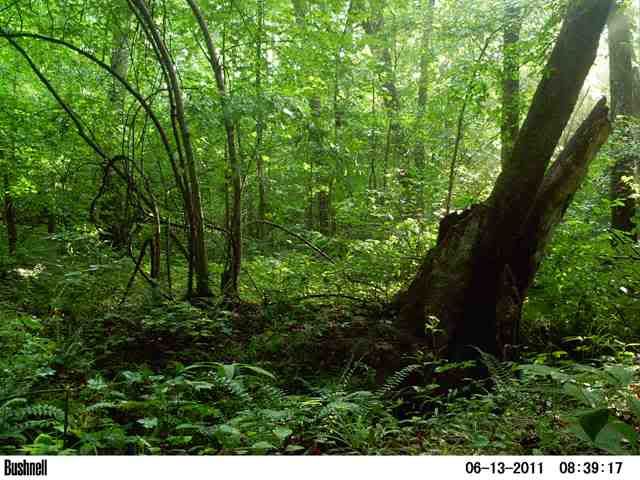

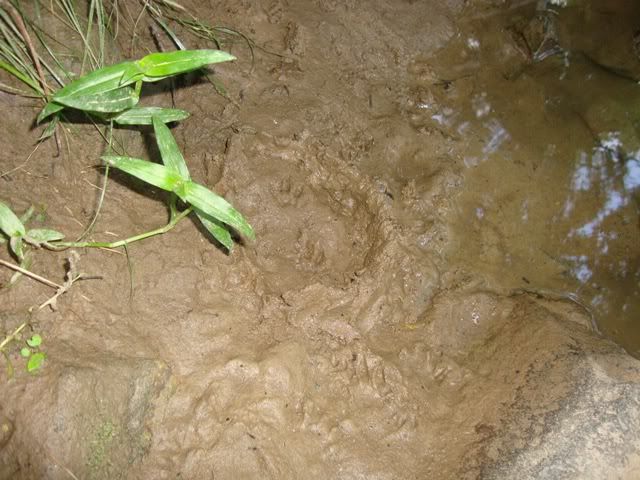
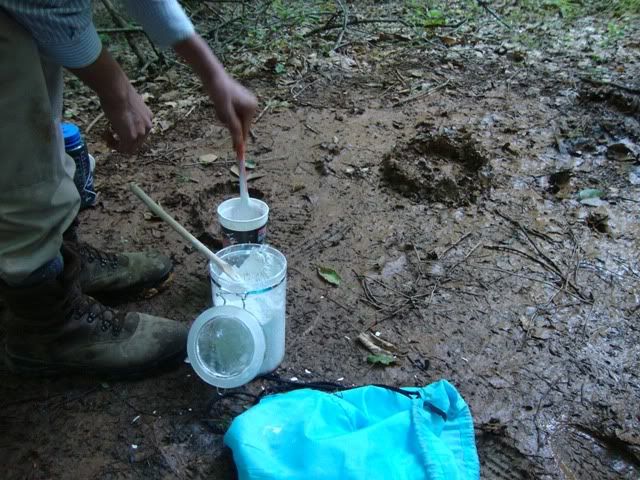
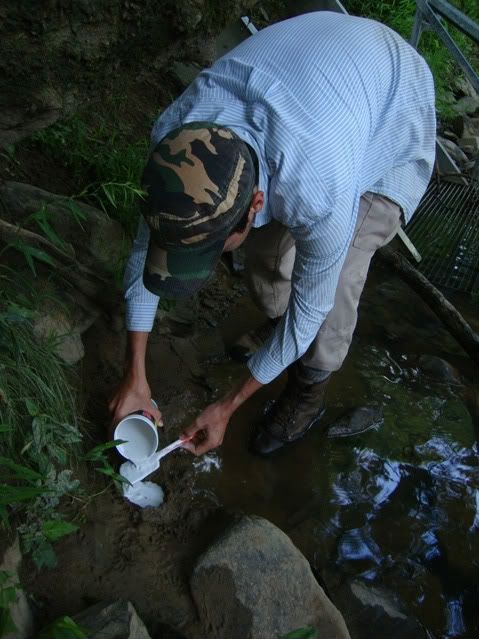
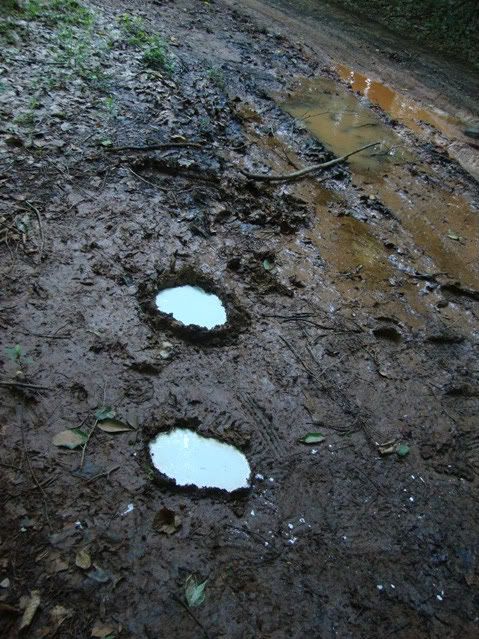
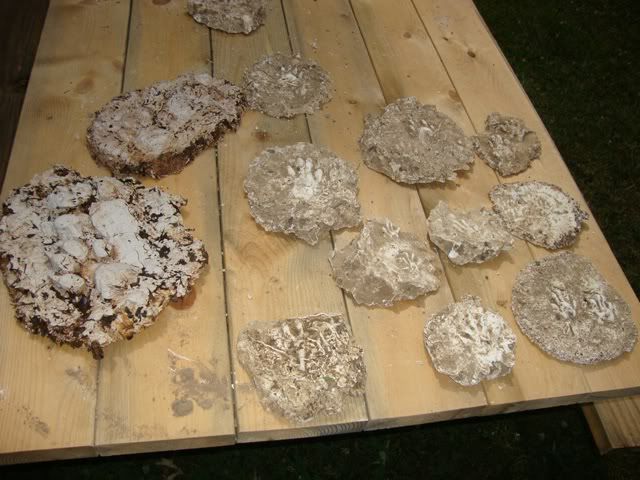
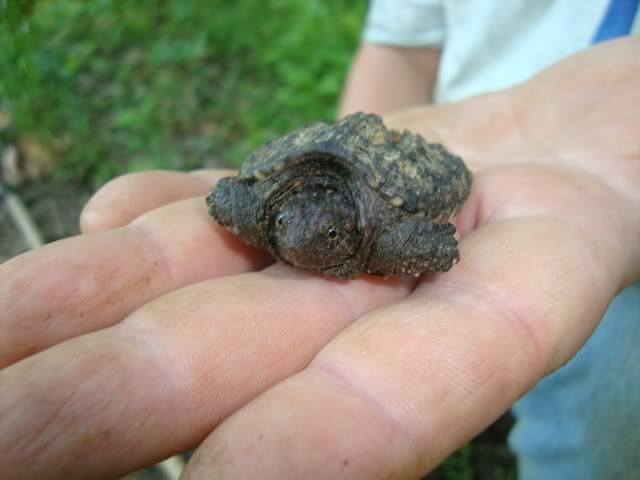

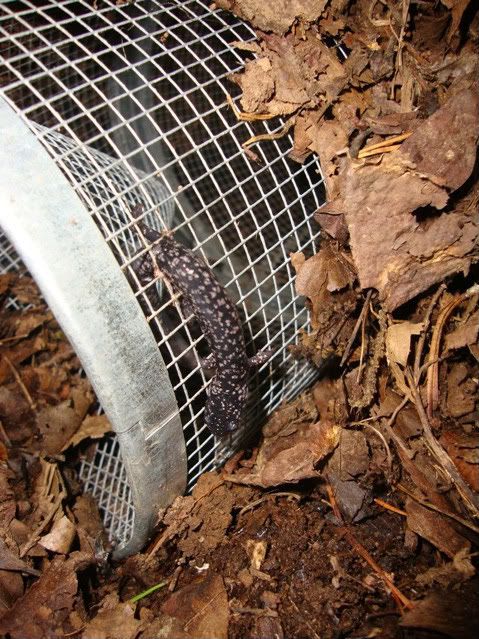
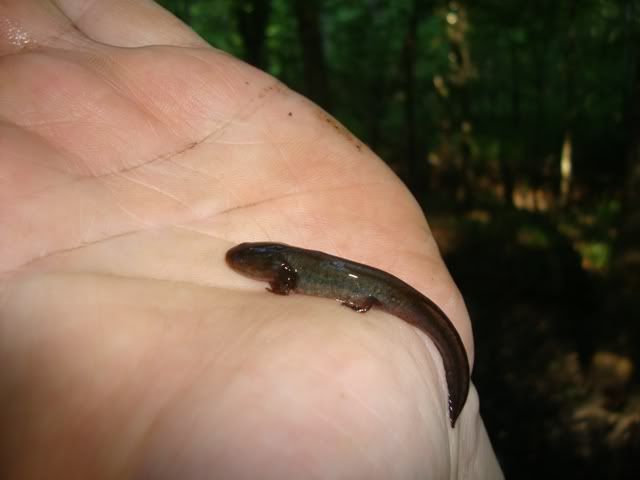

That's the smallest snapping turtle I've ever seen...incredible.
ReplyDeleteMaking those casts looks great fun. Next time I'm in lion country I'll try to make some for use in the suburbs!
ReplyDeleteThis comment has been removed by the author.
ReplyDeleteRealized I had a bunch of stupid spelling mistakes in my last comment....I wish Blogger would let one edit their comments. Instead I figured I'd just delete it and start over.
ReplyDeleteAnyways, thanks to both of you for commenting!
Jeremy....you should try casting lion tracks for sure!! How cool would it be to show off casts of wild African Lion tracks to folks?!
The biggest carnivore we can boast 'round here is the relatively diminutive Coyote....
Casting is actually pretty easy to do once you've done it a time or two. The hardest things about it are (a) remembering to buy the necessary supplies (for years I'd see tracks and say 'dangit, why don't I have any plaster?!'), (b) hauling those in the field with you and (c) getting the plaster to the right consistency when wet.....none of which are actually very hard, I might add.
If you have any questions about it, feel free to contact me: jkapfer@elon.edu
I love that landscape shot and now I really want to try casting some tracks. Great post as usual!
ReplyDeleteRandom question. I am assuming some dirt is always caught in the plaster right? Could you paint the plaster after the fact to specifically highlight the tracks?
Hey....
ReplyDeleteYeah, some dirt is almost always going to get in the cast...the amount depends on the type of soil and how dry it is.
If you happen to find a track in mud that has hardened...then you might get a pretty clean cast. This is probably unlikely, though. The best thing to do is clear out loose debris (sticks and leaves, etc.) before you put in the plaster. But you have to be careful...tracks are delicate and you can ruin the track by trying to pick debris out.
Also, once the cast has dried and you pull it out of the mud...you can rinse it thoroughly (assuming the plaster is dry enough). That will take most of the dirt off (especially if you have a stream nearby to dunk it in).
Alot of times...as the cast dries....the mud/dirt will flake away. But you'll almost always have some dirt on the cast.
You could surely paint the plaster after the fact (I think?). It's just plain old plaster-of-paris.
Getting the consistency right before pouring it in is important. Roughly two parts plaster to one part water (as it was told to me, it should be the consistency of a "cheap milkshake"). You can test to see if it's dry enough by running your finger lightly on the back of the plaster cast...if any chalky white comes off on your finger, it may need to dry more.
Hope that helps!
Ultimately, the best thing to do is take one of Dr. Halfpenny's tracking workshops. He lives in Montana, but does workshops all over North America. He teaches casting, identification, reading trails and gaits, etc..
I'd recommend taking a class in Montana with him (he lives in the Yellowstone Ecosystem...so it's cougars, grizzlies and wolves to cast tracks of!).
Check his website out here:
http://www.tracknature.com
Thanks for all the info, that is really great. I sadly have never done anything with plaster-of-paris -- that's what I get for growing up in Germany :). It would seem possible to paint them no problem (if one so desires of course).
ReplyDeleteMaking a cougar cast would be pretty awesome!
The tracknature site is interesting too, seems like he has done it all!
Plaster casting here I come. Thanks trailblazer.
Seabass
I'm intrigued by casting. I'm wondering if it works in snow since that's when I see the most tracks. If it did, I could perhaps start to identify how many different mountain lions pass through our forest in a given winter by comparing track casts. I've tried to do that based on measurements of tracks but have always felt dubious of my conclusions...
ReplyDeleteWhat a tiny snapping turtle!
Good luck, Seabass! Plaster-of-paris is easy to work with...so don't worry. Just get the consistency right. Can't wait to see some pics of your spoils!
ReplyDeleteKB, one can definitely cast tracks in the snow...but I've never done it. I think you have to spray them with something first to solidify it....but not sure what that would is...some sort of polymer?
Halfpenny does alot of work in the snow......man, his class would be awesome to take for you folks in the west! He does stuff in Colorado too, I think (which is where you are, right? I wanna say he teaches a workshop at the CU campus in Boulder every so often, but I don't know if he still does.
Anyways, check out his website....he's also written a number of tracking books that are available on amazon.
Seriously, though...track casting is almost as addicting at camera trapping! :) Once you get your first cougar track, you'll be hooked!
Let me know if you have any other questions....I'm not an expert, like Halfpenny...but I may be able to point you in the right direction.